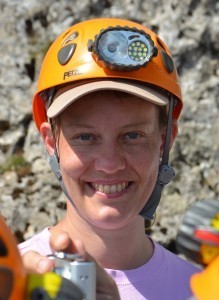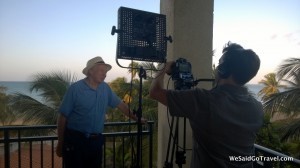Lisa Niver's Blog: We Said Go Travel, page 405
March 27, 2014
Walking in the Footsteps of Giants in Ireland
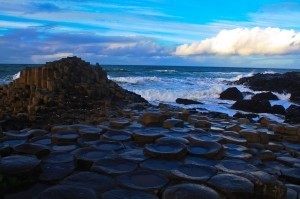 The sky had been playing games with us all day, constantly morphing from ominous grey to dazzling blue. It was December and this is Northern Ireland, so I can’t say that I expected perfect conditions. All I was merely hoping for was a few clear hours, as I had just dragged my wife clear across Ireland to visit this place. Rounding a bend shielded by cliffs, I saw it. Jutting out into the Irish Sea is a site where time stands still, where our stories from childhood seem possible, and where legend and reality harmoniously converge.
The sky had been playing games with us all day, constantly morphing from ominous grey to dazzling blue. It was December and this is Northern Ireland, so I can’t say that I expected perfect conditions. All I was merely hoping for was a few clear hours, as I had just dragged my wife clear across Ireland to visit this place. Rounding a bend shielded by cliffs, I saw it. Jutting out into the Irish Sea is a site where time stands still, where our stories from childhood seem possible, and where legend and reality harmoniously converge.
The Giant’s Causeway is a fairy tale brought to life. According to legend, Finn MacCool, the greatest of Irish giants, challenged his Scottish counterpart, Benandonner, to a duel. Finn then set enormous steeping stones across the sea so Benandonner could face the challenge. Finn fled as soon he saw the size of the Scottish giant and hid, dressed as a baby. Benandonner arrived at Finn’s home only to see a monstrous infant. Assuming the child was Finn’s and imagining the size of father, Benandonner raced back home, ripping up the causeway as he went. Sitting at the edge of the Giant’s Causeway today, staring at the horizon and knowing that directly across is Scotland, it is impossible not to envision the great colossus tearing the bridge down while in retreat.
The Giant’s Causeway is in fact a rock formation of the most unique kind. Created by volcanic eruptions, the Giant’s Causeway is a massive collection of columns made of basalt, an igneous rock. These columns were formed when lava leached its way through fissures in the surface and slowly cooled and cracked over time. The result was a place of ethereal, almost other worldly, beauty.
While visiting the causeway, the surroundings will astonish as much as the column’s, themselves. Set amongst the ruggedness of the Irish coast, the Giant’s Causeway provides stunning views of the jagged cliffs extending into the sea. The sound and spray of the water is also intoxicating. Here the roar of the waves echoes as it crashes into the columns; white caps sent sailing in a hypnotic ballet. The Giant’s Causeway breaks the tide in such a way that sitting on one of the columns near the sea, a visitor is treated to a veritable symphony of oceanic sounds; nature at its rawest and most elegant.
The Giant’s Causeway also allows us to relive some of the most marvelous parts of childhood. Explore without reservation. The Giant’s Causeway is nature’s playground. The columns rise and bend and twist creating the jungle gym we all wished we could have had. Run on them, sit on them, climb on them, skip from one to the next, become that 11-year-old that never let a little water or dirt stop them. Let your imagination run wild. Climb the cliffs overlooking the causeway. Stare down and retrace the remnants, imagining the bridge before the giant. Go to the Pipe Organ, and Giant’s Boot, formations connected with the causeway legend. It is these that bring Finn MacCool to life. Surrender completely to the rich folklore and see it through child’s eyes.
The Giant’s Causeway is that rare place that enthralls all ages. So come, lose yourself, and sense the majesty of nature and magic of storytelling.
About the Author: Bill Hoversen is a history teacher originally from Chicago, Illinois. A late-bloomer, Bill did not really begin travelling abroad until his mid-twenties after spending several months teaching in Vietnam. Bill currently teaches and lives in the Hungarian capitol of Budapest.
Thank you for reading and commenting. Please enter our next Travel Writing competition and tell your story.
The post Walking in the Footsteps of Giants in Ireland appeared first on We Said Go Travel.
March 26, 2014
A melodious moment in the USA; not a timed memory’
 What place makes us feel as alive and kicking as possible? What place makes us really live inside the moment and not in the periphery of a moment, as an outsider looking in? For some people this is an active rafting holiday in Canada, for others a stroll through the mountains in Norway, for some it’s spending a year on the road, travelling the world. And for some it means going to as many concerts as possible, in their own town or in a city they have never been before, because live music is something magical. From the time you enter a venue until the time you are out, sweaty and happy, the only thing that counts is the moment. That moment filled with music that makes you feel as if someone finally understands you or that makes you dance until you lose your breath. That moment that no one can take away from you.
What place makes us feel as alive and kicking as possible? What place makes us really live inside the moment and not in the periphery of a moment, as an outsider looking in? For some people this is an active rafting holiday in Canada, for others a stroll through the mountains in Norway, for some it’s spending a year on the road, travelling the world. And for some it means going to as many concerts as possible, in their own town or in a city they have never been before, because live music is something magical. From the time you enter a venue until the time you are out, sweaty and happy, the only thing that counts is the moment. That moment filled with music that makes you feel as if someone finally understands you or that makes you dance until you lose your breath. That moment that no one can take away from you.
Sometimes seeing your favorite band or artists play means that you’ll have to travel: Going to Amsterdam, to Paris, Berlin, London or anywhere in the USA where a tour might lead a band and the band might lead you. This means that you will inadvertently encounter a different culture, a different atmosphere, and perhaps even different mindsets. It also means meeting people from various places on earth and making friends. A concert venue can, therefore, be seen as a travel destination, just as much as a sandy beach in Spain or the coliseum in Italy.
In a music venue, time and atmosphere change and there is this scintillating vibe of living to a beat or a melody instead of a clock. Going to a concert of a band that you love means that you get to spend at least 1.5 to 2 hours living completely in the moment. Sometimes, however, the whole day leading up to a concert in the evening can feel as if time does not matter: The connections made because of that one band, the waiting in line, reconnecting with the people you have not seen in a while, and the anticipation of hearing that one song played live can make a person dance to the movement of time instead of walking steadily in its pace.
When you have finally passed security and successfully landed yourself and your friends a good spot, there’s the waiting. And yes, waiting can feel as a total waste of time. However, it can also feel as that time before Christmas when you know that Santa will come round with a lot of presents, but you have to wait an entire night or day for it. The moment of anticipation is part of the whole experience and if the moment lives up to that expectation then Christmas, your birthday, and New Year’s Eve coincide.
The most important realization you get from a music event (next to thinking that the band was really good and that music and/ or lyrics really speak to you, or how you enjoyed really letting go for a while) is that it’s not really about the money or about the amount of time you spend or have. It’s about the here and now. It’s about the moment, just this moment. That moment can last 2 weeks, 5 days, or just 5 minutes but how long it lasts is not really relevant. You can die tomorrow or you can live another 70 years. You can spend it waiting for the moment to come but you can also simply live the moment. In letting go of time you actually spend time living and isn’t that what time is made for? You can take pictures, since pictures say a 1000 words. But pictures are framed, frozen moments. They are merely a residue of life and living your life through pictures is a waste of time, because we only have one life.
‘Time to be alive’ 30 seconds to mars- ‘Do or die’
About the Author: Joyce Vos is an independent writer in the blogging, content writing, and translation field. Creative writing, travelling, and drawing/painting are also things she is passionate about.
Thank you for reading and commenting. Please enter our next Travel Writing competition and tell your story.
The post A melodious moment in the USA; not a timed memory’ appeared first on We Said Go Travel.
Poetry in sand in Mali
They are desert nomads who don’t accept frontiers of countries, a population without any place to belong. Like gypsies of the desert they live a harsh and lonesome life in this dry isolated wilderness.
It seems that one’s sense of time and orientation disappears – only the sun and the nuance of the scenery is a landmark. It feels like being absorbed by a mysterious creature, which holds you tight in its grip – and don’t let you leave – seducing and hypnotizing and carry one away – without you discover it.
Ahmed is praying in the soft late afternoon light. He gets down the camel, kneeling humble with his weather-beaten face towards Mecca. Silent sounds and mumbling comes out between his lips. We observe him with a kind of awe. The camels expel a gargling sound all the way from the stomach.
We arrive in the camp in the dusk. We are not able to see the town anymore – there is no light, except from a pale moon. Sand dunes with dry vegetation in pale green and brown colors bathed in strange light. The darkness appears and the fogged gigantic star constellation of the Milky Way is unfolded in all its grace.
I am listening to the foreign sounds, shiver and move myself closer to my friend, who is right next to me in his feather sleeping back. A touch of fear shows its face – what and who is walking around in the desert in the dark night? What do we know about desert nomads and star navigation?
We are on foreign ground in a foreign environment. These people are born here – the desert is their home, their territory, their “childhood town”, childhood memories – their whole soul. Close to the creation, close to the nature and this deafening silence, which is only to be found in deserts and the huge mountain ranges around the world. A land without frontiers, outside time and space – another dimension.
Ahmed saddles his camels with the same gentle touch and care as he was nursing a newborn child. One feels a very deep love to the animals out here; they know their worth and that one cannot manage life in the desert without their riding and cargo camels. The ship of the desert has meant everything to these people for centuries, ever since they started the transport of salt of the caravan routes in this outpost, on the edge of the enormous Sahara desert.
Slowly we ride in the lonely desert, leaving to a place with a small lonely bush, which is not much more than a couple of dry branches coming up from the sand. A narrow fringe of shadow is found on one side of the tree.
In this place Ahmed arrange a camp and he starts to collect twigs to a modest bonfire. He prepares the food and we get a simple meal consists of boiled rice and fish in a steel bowl. We share the same bowl. It’s intimate to share the same bowl.
My friend takes a photo in sepia. He sets the camera and captures a magical moment of a crackle bone dry little tree on a rise in the sand. The photo looks like an antique photography from a moment long time ago. A short second, a moment in the world history, which will never return.
Ahmed makes tea in a little dark blue enamel teapot. We witness a tea ceremony prepared and made with an almost royal dignity. He mixes sugar in the strong syrup like drink. Let it wait for a while and offers us the tea in a little single glass. The boiling strong tea hurts in the throat and gives a second taste like strong pepper pricking on the tongue. The third time the tea is being mixed with boiling water it’s more tasteful, more soft, gentle and delicious.
Suddenly out of nothing there is a man standing in the sand. He has appeared silent as ghost; he has been floating over the sand dunes. A young Tuareg man in a bright blue fluttering dress that blows in the gentle wind. Times stand still – words are unnecessary. He is being offered tea in the little glass. They talk so silent, that it feels just like a whispering. “The words are carried by the wind,” my friend says.
A ghost creature is emerging from nowhere in the sand, drink a tea, says ten words so low as the wind blowing in the dry bushes and leaves us again as silent as he has arrived. I follow him with the eyes, moved and fascinated until he is gone behind the dunes. I am closer to the universe and closer to understand. What is serenity? What is harmony?
Anette Lillevang Kristiansen
Thank you for reading and commenting. Please enter our next Travel Writing competition and tell your story.
The post Poetry in sand in Mali appeared first on We Said Go Travel.
In Nokia’s News!
 From March News for We Said Go Travel:
From March News for We Said Go Travel:
Thank you to Nokia for my Lumia 925 and for publishing my story about Manila! See photo on left and click here to read it!
I am continuing to publish three entries from our Inspiration Travel Writing Contest everyday. Our fourth Travel Writing Contest ended on February 14, 2014 with 505 people from 55 countries involved. There will be more entries published for all of March and April. Read all the stories published so far: Click here! Winners will be announced in May. If you participated in the contest, you will receive an email from me when I get your article ready for publication. Thank you for your patience!
Our FIRST travel video contest in conjunction with Richard Bangs will happen this summer with truly incredible prizes!! There will also be another writing contest on the theme of Independence this summer.
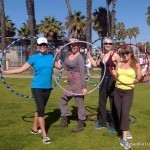 Recent Articles and Interviews: Thank you to Tim Leffel for sharing My Five Things I always Pack: including my hula hoop! Thank you to “THE GUY” for interviewing us for his Travel Blogger Interviews. Thank you to Hotels Cheap for interviewing me about Long Term Travel: Click here to read it.
Recent Articles and Interviews: Thank you to Tim Leffel for sharing My Five Things I always Pack: including my hula hoop! Thank you to “THE GUY” for interviewing us for his Travel Blogger Interviews. Thank you to Hotels Cheap for interviewing me about Long Term Travel: Click here to read it.
MORE PLACES: Enjoy these recently posted articles about Palau, Le Meridien Chiang Mai, Chiang Rai, Guam, Kuala Lumpur, and Hawaii.
Article coming soon about Los Angeles and Adidas: See below for photo and click here for Video of Noah Maze Yoga and Katie Eychis Hula Hooping class from Hoopnotica.
Thank you for your support. Connect on Facebook, Google+, Instagram, LinkedIn, Pinterest, SlideShare, Twitter, and YouTube.
We now have just over 1500 posts on We Said Go Travel and nearly 190,000 views on YouTube! Thanks again! Lisa
(Click here to sign up for this newsletter. )
Traveling in Sin is a HOT NEW Release on Amazon! from Lisa Niver Rajna
The post In Nokia’s News! appeared first on We Said Go Travel.
The Adventures of a MidWesterner in Rural Kenya
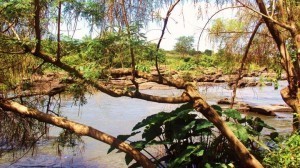 The Adventures of a MidWesterner in Rural Kenya
The Adventures of a MidWesterner in Rural Kenya
6 am, Thika, Kenya. The dim light spreading over the concrete floor of my dusty dorm room slowly melts into quiet wakefulness. The background noise of the river and jungle birds coaxes me awake almost as convincingly as it holds me in the last moments of sleep, just listening.
The growing light and warmth of the day push me from a tangle of sandy sheets and scratchy mosquito netting. Washing my face from a water bottle and draping the washcloth over the window bars to dry, the simultaneous weight of humidity and the coolness of morning settle around me, a second layer of clothes. With the help of the window sunlight I clumsily manage to get in my contacts. Blinking out through the window the jungle morning comes into a peaceful focus.
6:30 am. A small blue airplane blanket, a notebook, my iPod and a shady rock by the river. Even seeing it before my eyes it’s hard to take in the lush, crashing picture of birds and trees dipping in and out of the rivers cold, tumbling water. It’s even harder to connect the river with the muddy, trash filled streets it flows through in Nairobi before wending its way down to the jungle retreat center. I sit hugging my knees and forgo the noise of my iPod for the music of water and rocks having early morning conversations.
7am. Breakfast with everyone gathered around tables we pushed together on the patio of the kitchen building. I’ve learned to ignore the tiny ants in the bread, instead smothering them with grainy peanut butter and mounds of jelly. We fill our plastic cups with hot chocolate, tea and instant coffee, sipping while we chatter about whether the shadowy mountain in the distant is close enough to walk to in a day. “No, no, no” our Kenyan teacher tells us, “you must have a special guide to keep you safe. There are deadly buffalo.” We all laugh, although he is very serious.
The day moves earnestly on, class time, tea time, more class time. In the afternoon we explore along the river. Down stream there is no trail only the thick tangles of vines and underbrush filled with lizards and mosquitos. I should have worn shoes, but we’re too far now and my sandaled feet have seen enough barefoot summers to brush off the rough twigs and rocks. The river opens up now and then and stretches into shallow rocky lakes with small islands of palm trees. Several people turn back, tired and ready to trade the spirit of adventure for a cool shower and a nap in the sleepy warmth of late afternoon. I scramble on with the remaining expedition, not willing to let these extraordinary moments go unsavored.
We spend the rest of the afternoon at a shallow waterfall, diving under the bubbling rapids to collect handfuls of smooth rock. Sprawled out across the rocks I soak up every heady moment of heat and the heaviness of tropical air, feeling my skin stretch tight with sunshine and drying water.
6am, Ohio, United States. Rolling over still half asleep I look out into the darkness of a damp, cold February morning. The glass of my window is cold to the touch and I snuggle deeper into my blankets. Closing my eyes I still hear the sounds of jungle birds and a rushing river in my memories as I drift through the last moments of sleep, just remembering.
About the Author: My name is Lara, an excitable 20-something from the MidWest of the United States. Traveling and writing are two of my greatest joys.
Thank you for reading and commenting. Please enter our next Travel Writing competition and tell your story.
The post The Adventures of a MidWesterner in Rural Kenya appeared first on We Said Go Travel.
March 25, 2014
View Over Vilnius, Lithuania
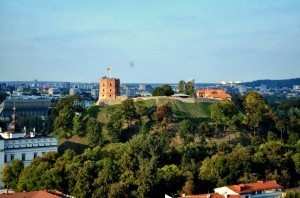 Gedimino Hill bursts out of the historic center of Vilnius. It is capped by a rebuilt medieval tower that recalls the castle that once stood there, the seat of medieval dukes. It was here that the Baltic Way, a chain of peaceful people linking hands and protesting Soviet rule, originated in 1989. That chain stretched almost 370 miles through Lithuania, Latvia, and Estonia, countries grouped culturally, geographically, and historically. A black-and-white video loop shown in the tower reveals the faces of people who shared a common hope and carried it like the candles they lit as part of their plea for independence.
Gedimino Hill bursts out of the historic center of Vilnius. It is capped by a rebuilt medieval tower that recalls the castle that once stood there, the seat of medieval dukes. It was here that the Baltic Way, a chain of peaceful people linking hands and protesting Soviet rule, originated in 1989. That chain stretched almost 370 miles through Lithuania, Latvia, and Estonia, countries grouped culturally, geographically, and historically. A black-and-white video loop shown in the tower reveals the faces of people who shared a common hope and carried it like the candles they lit as part of their plea for independence.
When I traveled to Vilnius, Gedimino Hill beckoned on my first day in the city. A cobbled path curls around it to its apex from its entrance from the park at its base. I ascended the hill, step by cobbled step, stopping to admire the view: the three white crosses shining on their wooded hill, the Neris River at its stately crawl, and the old town spreading out like a gift with its university bell tower, churches of eastern denominations, and former palaces in Baroque and Neoclassical style.
It’s not always easy to imagine yourself in the position of those who came before you. But Gedimino Hill elicits feelings of what it symbolizes. The village is the heartbeat of Lithuania, and surrounding its tower rambles the country’s biggest village. Its people strive and struggle, love and learn under the confluence of their own culture and the bureaucratic and political dross left over from Soviet rule, which ended in 1991. As a result, getting to the essence of the Lithuanian soul can mean looking backward, then farther backward to when Gediminas built his castle on the hill and before, to when the Lithuanians were tribes clinging to their pagan ways as Christianity made a swathe through Europe. The people of Lithuania do not recognize their complexity—to them, it is normal to be both pagan and Christian, both villager and city dweller. But they are fiercely proud of their folk traditions and ancient, slow-changing language, as well as their independence from oppressive forces that attempted to wrest from them their identity.
Vilnius is not one of Europe’s tourist centers. Riga, Latvia’s crowning city, unabashedly attracts bachelor and bachelorette parties from the United Kingdom; Tallinn’s marketing is as savvy as its technology, and tourists take to the Estonian capital willingly. Vilnius is neither party central nor cutting edge. It is a humble place, a place for reflection, a place for private celebration. Gedimino Hill, though it is, by right, one of the major attractions of the city, is a private-feeling place, one that is, at the same time, utterly accessible. It is free year-round and sometimes open 24 hours: it could not be either if it were in Riga or Tallinn.
I have ascended the hill in the summer, when the city sees the highest influx of outsiders. I have picked my way up the treacherous slope, slick with ice, during winter, when the wind at the top found its way into my sleeves and collar. I have ventured to the top at night, when the moon shimmered behind clouds and cast its light through autumn-golden birch leaves. Gedimino Hill is not just for tourists.
When in Vilnius, I visit Gedimino Hill when I need a new perspective on the city, on life, on myself. As must have been recognized by the Lithuanians who linked hands for the Baltic Way, this place is pregnant with the past as well as with possibility. We are like that when we travel, carrying our hope in a flame that connects us with those in our village, wherever that may be.
About the Author: Kerry Kubilius is a writer focusing on Eastern Europe.
Thank you for reading and commenting. Please enter our next Travel Writing competition and tell your story.
The post View Over Vilnius, Lithuania appeared first on We Said Go Travel.
Malapascua: Remembering Eternity in the Philippines
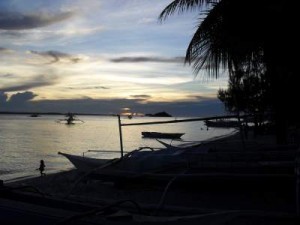 It no longer exists, not as it was on that farewell New Year’s Eve when I counted the fireworks enflaming the sky. Malapascua – a small island in the Philippine chain – was buried under the sea waters the typhoons brought last year. Aerial photos show a mess of corrugated iron and bowed, broken palm trees. The pristine beaches have been annihilated, the boats blown away. All that remains now (if and until the people can rebuild) are the fragments of memory that erupt in an instant and then go dark.
It no longer exists, not as it was on that farewell New Year’s Eve when I counted the fireworks enflaming the sky. Malapascua – a small island in the Philippine chain – was buried under the sea waters the typhoons brought last year. Aerial photos show a mess of corrugated iron and bowed, broken palm trees. The pristine beaches have been annihilated, the boats blown away. All that remains now (if and until the people can rebuild) are the fragments of memory that erupt in an instant and then go dark.
I arrived on Christmas Day in 2009 eager for a week on the beach in respite from winter. The trip there had been a harrowing one, involving nearly-missed flights and a treacherous half-day taxi ride through the rain along twisting roads bordered by jungle and precipices. That was before I even set foot on the shambles of twigs and buoys the locals called a boat, the only ferry from the top of Cebu across a stretch of sea to the island.
Exhausted, I landed in a world of natural night, lighted – as no night had ever been for me in the heavily inhabited regions I have lived in all my life – by only the moon and stars. The boat was unable to dock, so I jumped into the temperate clear waters and wandered towards the hotel beacons farther down the beach.
Malapascua means “Bad Easter” in Spanish, named by sailors when rough weather stranded them there on Christmas Day while exploring conquered territories. The native name may exist in local remembrance, but the world calls it by its Spanish curse. Its reputation amongst tourists comes from the excellent snorkeling and diving to be had in the waters that surround it. Tropical fish, sharks, sunken ships, and reefs are easily accessed within a mile of the beach.
I came for that as well, but my pleasure turned out to be of a simpler sort: watching the sea roll in with an infinite number of variations. Every day, I found myself delaying my plans, drawn to the reflection the water offered. The sun was joyful but not insistent, leaving the sand refreshingly cool. On the beaches away from the hotel area, the Filipino families spent their afternoons. Children played their games in the surf while the adults hurried between their tin shacks and work. Some teenagers came by and tried to sell trinkets for a little extra cash. The old sat around the rickety buildings just beyond the sand. The whole of life was visible from any spot with the waves calling out the seconds as everyone transitioned between their stages.
I was surprised by how long the afternoons lingered. My only distractions were a book (appropriately titled Freedom) slowly collecting sand in its binding, my notebook, and my pen. Watching the sun fall over the sea, every day surprised me in not being a week. The mind has so many thoughts to think when it doesn’t have the glimmer of a computer screen and a phone to distract it.
It was by no means a perfect place. The poor were too poor, the hotels encroached a little too much into life. The food was mediocre and the tourists made too much noise. A busy life might wonder at the madness of wasting so much time staring out into the sea. Yet I found my minutes much better spent counting the sand grains than hustling through the city as I usually do. The days pulled me away to other activities, but I was always drawn back to the beach and the quiet thoughts it offered.
Paradise is a loaded word – touched as it is with associations of heaven, reward, and the immortal – but it is fitting for Malapacua. If there is anywhere worth settling down for innumerable years, it would make a good choice. When I left after the New Year’s celebrations, the overcast sky finally broke into a downpour of goodbyes. I promised myself to come back soon and live out my rest of my time sitting on that beach.
Yet it was brushed away in a matter of days. Four years – not eons – it survived before rapine rains overwhelmed the island. Thus, Malapascua not only taught me to appreciate the little moments, but also how limited they are. It makes Arnold Bennett’s claim that “no one can take time from you” the more painfully true. The lesson of Malapascua is the need to appreciate our lucky hours. If we make every minute an eternity, then there is still some eternity for Malapascua.
About the Author: Seth Libby is an American writer living in Russia. He works mostly in fiction but also engages in travel writing. Having completed his first novel, Seth is currently trying to find a publisher.
Thank you for reading and commenting. Please enter our next Travel Writing competition and tell your story.
The post Malapascua: Remembering Eternity in the Philippines appeared first on We Said Go Travel.
The stunning Roseland Peninsula in Cornwall, UK.
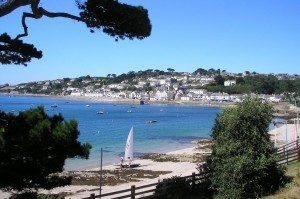
View of St. Mawes. Image courtesy of Google Images.
The Roseland Peninsula in west Cornwall, known locally as just, “Roseland” is home to the town of St Mawes, and the small village of Portscatho. St. Mawes lies nestled at the very tip of the peninsula. It is a beautiful traditional fishing village, offering many charms. Quaint winding roads lead to spectacular views of wonderful rolling farmland and stunning historic buildings. Portscatho is another great village along the peninsula. Portscatho rests on a sloping hill down to the waters edge which gives nearly all of the town un-interrupted wonderful breathtaking views of the Cornish coast. Benefiting of this high vantage point you can see for miles upon miles the ragged and stunning coastline. These two great towns offer a plethora of touristic options that can cater to any family on vacation to this little slice of UK paradise.
Many tourists come to this part of the UK to relax by the sea and enjoy the relaxing village life for a week or two. Most of them decide on the great option of renting out a cottage instead of being in a cramped hotel room. Cornwall cottage holiday breaks are a great alternative to hotels as they are a home away from home. Instead of being cramped in a one room or two room hotel room, cottages provide a true home away from home. Most of them have unobstructed views of the ocean, are dog friendly and are a full size homes which means that personal space is not a problem, unlike hotel rooms.
The largest town on the Roseland Peninsula is St. Mawes. St. Mawes is a small fishing village and is home to three boatyards and is famous for sailing. Being positioned within the gulf stream the climate in St. Mawes is mild year round which makes for great sailing. If you’re not the one for sailing, visiting the St. Mawes Castle or walking and exploring the town is a great alternative to spending the day at sea.
Another great village on the Roseland Peninsula is Portscatho. The small village is on top of a sloping hill which means from this high vantage point you can see for miles upon miles the ragged and stunning coastline. Some people spend a day or two taking in the natural beauty of this village.
Obviously, taking a break out of a busy schedule to visit this small corner of the UK is time well spent. Whether it be a weekend, week or month, the Roseland Peninsula has a little something for everyone to enjoy.
The post The stunning Roseland Peninsula in Cornwall, UK. appeared first on We Said Go Travel.
#RBQuests: Livin’ La Vida Loca Day 2 Puerto Rico
 Hello from Puerto Rico! I wanted to share a few photos from Day Two of filming with Richard Bangs andWhite Nile Media! This week we are creating videos forPRTourismCo and Orbitz Originals.
Hello from Puerto Rico! I wanted to share a few photos from Day Two of filming with Richard Bangs andWhite Nile Media! This week we are creating videos forPRTourismCo and Orbitz Originals.
Wondering what we are doing? I will be sharing social media with the tag #RBQuests. Use this link to the TagBoard or see below to follow along.
I loved Sunrise at the Wyndham Grand Rio Mar and hula hooping on the beach. My first night I was out with Juan Ortiz, Mr. Gay World Puerto Rico clubbing in Santurce and my second night I was interviewing him at sunset on my balcony!
Behind the scenes with Didrik and Richard!
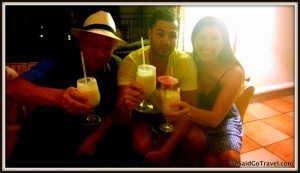 Pina Coladas were invented in Puerto Rico and they are fantastic post interview. In photo: Richard Bangs, Juan Ortiz and Lisa Niver Rajna.
Pina Coladas were invented in Puerto Rico and they are fantastic post interview. In photo: Richard Bangs, Juan Ortiz and Lisa Niver Rajna.
Photos coming soon from golfing the famous 16th hole on the Ocean Course at the Wyndham, kayaking and an incredible water park! Thanks for participating with us! Lisa
Do you have any Puerto Rico favorites? Share them in the comments below! Maybe we will film there next!
Thanks for following along! Lisa
The post #RBQuests: Livin’ La Vida Loca Day 2 Puerto Rico appeared first on We Said Go Travel.
From Horrified to Beautified:India’s Trains
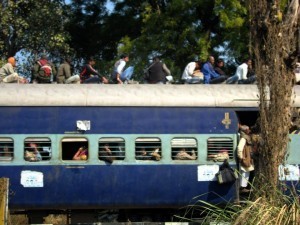 “Let’s take one of the sleeper class trains, it’s more economical and culture friendly,” Billy said enthusiastically.
“Let’s take one of the sleeper class trains, it’s more economical and culture friendly,” Billy said enthusiastically.
“No way, I’m scared! It seems dangerous; I bet criminals ride it. We will probably get robbed while sleeping. Let’s take first class with private rooms and locked doors. I heard it’s much safer for women,” my frightful self demanded.
“We won’t get the full culture experience locked away in first class. And besides, I’ve already bought our tickets for sleeper class.”
“Why in the world would you do that to me? I want to be comfortable while sleeping; I don’t want to have to sleep with one eye open and crammed among stacked berths in tiny, open compartments. What if we catch an illness, what if there’s rats, what if…”
“You’ve always wanted to backpack across India, but have held back for years because of your fears. And now that you are finally here, you need to get over your crazy worries once and for all.”
I sighed knowing that he was right. And later, I reluctantly boarded a sleeper class carriage.
I was horrified at the scene! I sat close to Billy, trying not to make eye contact with the panhandlers who were dragging their amputated bodies across the filthy floor and desperately tapping my shoulder for money. There were too many begging palms to hand out to, so instead I sent them silent prayers.
Then I looked out the window to avoid dozens of piercing stares; men’s expressionless faces with eyes that seemed to undress me, leaving me squirming and wanting to hide under a rock. Fortunately, the countryside passing by comforted me: Yellow wild flowers, miles of green fields, children riding water buffalos…
But the serene views were disrupted when ten skeletal Indians squeezed in our row that had comfortably sat three. I was now pushed up against the window. My eyes bulged out further watching locals boarding with live chickens, screaming goats, barrels of grains and everything else one can imagine that does not belong on a passenger train.
It was beyond crowded – OverOverOvercrowded! It seemed as though everyone had no concept of space: You sat shoulder to shoulder and if your lap was free, then you held someone’s extra baby, bags or chickens. If there were no more seats, then you stood on top of someone, slept in aisles, climbed on the rooftop or even squeezed underneath a seat. You could cough on someone and no one cared, you could drink out of a stranger’s water bottle and that was fine, anything you had could be shared and I mean anything.
As a result, I felt suffocated from the claustrophobic carriage, nauseous from the concoction of rancid smells… And the bathrooms were a whole other nightmare! I wanted to jump off the train until Billy whispered to me in excitement, “This is awesome. There is so much happening on this train. I’m glad you gave it a go. I love it!”
And for the first time in my life, time stopped! I had never witnessed anything like this train madness – madness that was beautiful. All my fearful voices ceased, all my judgments evaporated, all my anxiety fled… and I was finally free – free to see everything from a clear, blissful love. He was right again; this was awesome!
There were mothers giving life to their babies by breast feeding them on the floor, strangers generously making room to let others rest their feet, families offering me chapatis, children practicing their English with me and even the poorest people giving rupees to those less fortunate than them, the panhandlers. There were all walks of life on the train sparking up genuine, curious conversations with us or made up sign language. It was a beautiful scene.
That night I crawled up in my top berth with a bigger heart. Feeling humble and grateful for the experience, I fell asleep being gently rocked by the swaying train and the sounds of a humming engine that propelled me forward to a brighter future with fresh, new eyes.
And several months later, as we waited at a platform for our final train to Delhi, I looked forward to riding in sleeper class; despite that it was midnight, the train was two hours late, the electricity was out, insects nibbled us and rats scurried nearby. Things that would have caused me to scream farewell in the past no longer bothered me because I had conquered my fears and transcended my judgments. India railways had inspired me to live wholeheartedly with no regrets!
It was evident that I was not the same girl who first got on a sleeper class carriage a few months prior. The excitement and colorful culture of India had transformed me. I was going to miss its magical rides.
About the Author: Sabrina Soares from California is an elementary teacher who loves adventures. She is currently self-publishing a book about fear, love and change based on her year long experience teaching in Bhutan.
Thank you for reading and commenting. Please enter our next Travel Writing competition and tell your story.
The post From Horrified to Beautified:India’s Trains appeared first on We Said Go Travel.
We Said Go Travel
We Said Go Travel is a global community of over sixteen hundred writers with articles from every continent.
Stories are shared with photos and video from a perspective of the transformative power of travel. We Said Go Travel has hosted live and online events as well as travel writing contests around the world. ...more
- Lisa Niver's profile
- 57 followers


